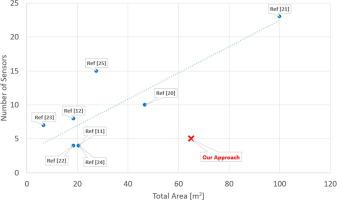Energy and Buildings ( IF 6.7 ) Pub Date : 2021-02-09 , DOI: 10.1016/j.enbuild.2021.110810 Chenli Wang , Jun Jiang , Thomas Roth , Cuong Nguyen , Yuhong Liu , Hohyun Lee

|
Based on the data from U.S. Energy Information Administration (EIA), the total annual energy consumed by buildings in the United States has increased by 325% over the past 70 years. Many commercial buildings utilize a building management system (BMS) and occupancy sensors to better control heating, ventilation, and air conditioning (HVAC) systems. However, the complex and costly installation process of occupancy sensors prolongs the return on investment for the residential sector. This paper presents a cost-effective approach to occupancy detection utilizing a two-layer detection scheme based on data obtained from multiple non-intrusive sensors (temperature and motion). The sensor data were consumed by multiple heuristic models (lower layer) for recognizing a set of human activities (door handle touch, water usage, and motion near the door area). As non-intrusive sensors, such as temperature sensors, may lead to less accurate occupancy information, a data fusion scheme using machine learning (upper layer) is utilized to holistically validate any individual sensor. The proposed two-layer methodology enhances the validity and reliability of occupancy detection. The human activities data was used to train and test four machine learning models (Random Forest, Decision Tree, K-Nearest Neighbor, and Support Vector Machine). The proposed occupancy detection system was installed in a 62 m2 living lab. Four temperature sensors and one motion sensor were used to collect the environmental information for 54 days. The validity of the proposed detection system was verified by the accuracy and the F1-score of each model. In all machine learning models, the two-layer detection system showed significant improvements to the accuracy and the F1-score over the current state-of-the-art approach with the same data. As such, the proposed work demonstrated similar or improved level of the accuracy (95%) and F1-score (95%) over other works, while using reduced sensor density.
中文翻译:

集成传感器数据处理,用于住宅建筑中的占用检测
根据美国能源信息署(EIA)的数据,在过去70年中,美国建筑物的年度总能耗增加了325%。许多商业建筑物都使用建筑物管理系统(BMS)和占用传感器来更好地控制供暖,通风和空调(HVAC)系统。但是,占用传感器的安装过程复杂且成本高昂,从而延长了住宅领域的投资回报率。本文基于从多个非侵入式传感器(温度和运动)获得的数据,提出了一种利用两层检测方案进行占用检测的经济有效方法。传感器数据被多个启发式模型(下层)消耗,用于识别一组人类活动(门把手触摸,用水和门附近区域的运动)。由于非侵入式传感器(例如温度传感器)可能会导致准确度较低的占用信息,因此使用了使用机器学习(上层)的数据融合方案来全面验证任何单个传感器。所提出的两层方法提高了占用检测的有效性和可靠性。人类活动数据用于训练和测试四种机器学习模型(随机森林,决策树,K最近邻和支持向量机)。拟议的占用检测系统安装在62 m 所提出的两层方法提高了占用检测的有效性和可靠性。人类活动数据用于训练和测试四种机器学习模型(随机森林,决策树,K最近邻和支持向量机)。拟议的占用检测系统安装在62 m 所提出的两层方法提高了占用检测的有效性和可靠性。人类活动数据用于训练和测试四种机器学习模型(随机森林,决策树,K最近邻和支持向量机)。拟议的占用检测系统安装在62 m2个生活实验室。使用四个温度传感器和一个运动传感器收集了54天的环境信息。每个模型的准确性和F1分数验证了所提出的检测系统的有效性。在所有机器学习模型中,两层检测系统均显示出与当前具有相同数据的最新方法相比,准确性和F1分数有了显着提高。因此,与其他工作相比,拟议的工作展示了相似或更高的准确度(95%)和F1分数(95%),同时使用了降低的传感器密度。


























 京公网安备 11010802027423号
京公网安备 11010802027423号